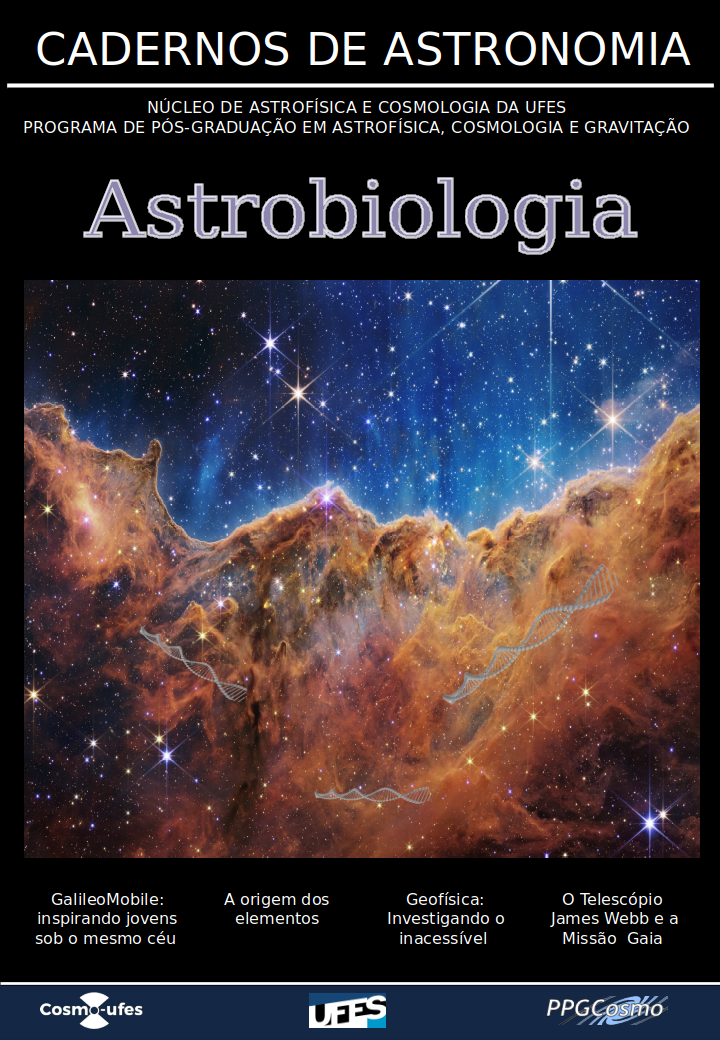A procura por exoplanetas habitáveis
DOI:
https://doi.org/10.47456/Cad.Astro.v3n2.38610Palavras-chave:
astrobiologia, exoplanetas, zona habitável, trânsito primário, velocidade radialResumo
Desde a descoberta dos primeiros planetas fora do Sistema Solar, os chamados exoplanetas, na década de 90, mais de 5000 exoplanetas já foram descobertos, além dos milhares de candidatos sendo analisados. A descoberta de que existem sistemas planetários ao redor de outras estrelas, suscita naturalmente o questionamento sobre a possibilidade de que esses exoplanetas possam hospedar vida. É nesse contexto que ganha cada vez mais destaque a astrobiologia, área de pesquisa multidisciplinar que consiste no estudo da origem e evolução da vida no Universo. Neste artigo apresentaremos uma breve revisão sobre a procura por exoplanetas e os principais resultados interessantes do ponto de vista da astrobiologia até o momento. Iniciaremos pela definição do conceito de zona habitável estelar, região em torno de uma estrela na qual é, em princípio, possível manter água no estado líquido na superfície de um planeta rochoso. Comentaremos sobre a procura por vida no Sistema Solar, descreveremos os principais métodos de detecção de exoplanetas e apresentaremos exemplos de exoplanetas com particular interesse astrobiológico. Finalizaremos comentando sobre a procura pelas chamadas bioassinaturas e tecnoassinaturas, indicadores da existência de vida fora da Terra, e as missões presentes e futuras com maior potencial para novas descobertas na área da astrobiologia.
Downloads
Referências
A. Wolszczan e D. A. Frail, A planetary system around the millisecond pulsar PSR1257 + 12, Nature 355(6356), 145 (1992).
M. Mayor e D. Queloz, A Jupiter-mass companion to a solar-type star, Nature 378(6555), 355 (1995).
R. Di Stefano et al., A possible planet candidate in an external galaxy detected through X-ray transit, Nature Astronomy 5, 1297 (2021).
W. J. Borucki et al., Kepler Planet-Detection Mission: Introduction and First Results, Science 327(5968), 977 (2010).
S. B. Howell et al., The K2 Mission: Characterization and Early Results, Publications of the Astronomical Society of the Pacific 126(938), 398 (2014). ArXiv:1402.5163.
M. Auvergne et al., The CoRoT satellite in light: description and performance, Astronomy & Astrophysics 506(1), 411 (2009). ArXiv:0901.2206.
G. R. Ricker et al., Transiting Exoplanet Survey Satellite (TESS), Journal of Astronomical Telescopes, Instruments, and Systems 1, 014003 (2015).
J. Schneider et al., Dening and cataloging exoplanets: the exoplanet.eu database, Astronomy & Astrophysics 532, A79 (2011). ArXiv:1106.0586.
J. F. Kasting, D. P. Whitmire e R. T. Reynolds, Habitable Zones around Main Sequence Stars, Icarus 101(1), 108 (1993).
R. K. Kopparapu et al., Habitable Zones around Main-sequence Stars: New Estimates, Astrophys. J. 765(2), 131 (2013). ArXiv:1301.6674.
R. K. Kopparapu et al., Habitable Zones around Main-sequence Stars: Dependence on Planetary Mass, Astrophys. J. Letters 787(2), L29 (2014). ArXiv:1404.5292.
I. Mitrofanov et al., The evidence for unusually high hydrogen abundances in the central part of valles marineris on mars, Icarus 374, 114805 (2022).
I. Mitrofanov et al., Fine resolution epithermal neutron detector (frend) onboard the exomars trace gas orbiter, Space Science Reviews 214 (2018).
J. Vago et al., ESA ExoMars program: The next step in exploring Mars, Solar System Research 49, 518 (2015).
R. G. G. Farias, Inuência de características orbitais e atmosféricas na estabilidade da temperatura de exoplanetas, Trabalho de Conclusão de Curso, Bacharelado em Ciências Biológicas: Biotecnologia, Universidade Federal do Rio de Janeiro, Rio de Janeiro (2019).
D. M. Kipping, Transit timing effects due to an exomoon, Mon. Not. Roy. Astron. Soc. 392(1), 181 (2009). ArXiv:0810.2243.
J. W. Lee et al., The sdB+M Eclipsing System HW Virginis and its Circumbinary Planets, Astronom. J. 137(2), 3181 (2009). ArXiv:0811.3807.
M. Gillon et al., Seven temperate terrestrial planets around the nearby ultracool dwarf star TRAPPIST-1, Nature 542(7642), 456 (2017). ArXiv:1703.01424.
M. Gillon et al., Temperate Earth-sized planets transiting a nearby ultracool dwarf star, Nature 533(7602), 221 (2016). ArXiv:1605.07211.
M. Turbet et al., A Review of Possible Planetary Atmospheres in the TRAPPIST1 System, Space Science Reviews 216(5), 100 (2020). ArXiv:2007.03334.
D. R. Louie et al., Simulated JWST/NIRISS Transit Spectroscopy of Anticipated Tess Planets Compared to Select Discoveries from Space-based and Ground-based Surveys, Publications of the Astronomical Society of the Pacific 130(986), 044401 (2018). ArXiv:1711.02098.
D. Schulze-Makuch et al., A Two-Tiered Approach to Assessing the Habitability of Exoplanets, Astrobiology 11(10), 1041 (2011).
J. S. Greaves et al., Phosphine gas in the cloud decks of Venus, Nature Astronomy 5, 655 (2021). ArXiv:2009.06593.
S. Smith et al., A radio technosignature search towards Proxima Centauri resulting in a signal of interest, Nature Astronomy 5, 1148 (2021). ArXiv:2111.08007.
L. Pasquini et al., CODEX: the highresolution visual spectrograph for the E-ELT, in Ground-based and Airborne Instrumentation for Astronomy II, editado por I. S. McLean e M. M. Casali, International Society for Optics and Photonics (SPIE, 2008), vol. 7014, 573 - 581.
H. Rauer et al., The PLATO 2.0 mission, Experimental Astronomy 38(1-2), 249 (2014). ArXiv:1310.0696.
Downloads
Publicado
Como Citar
Edição
Seção
Licença
Copyright (c) 2022 Beatriz Siffert

Este trabalho está licenciado sob uma licença Creative Commons Attribution 4.0 International License.






